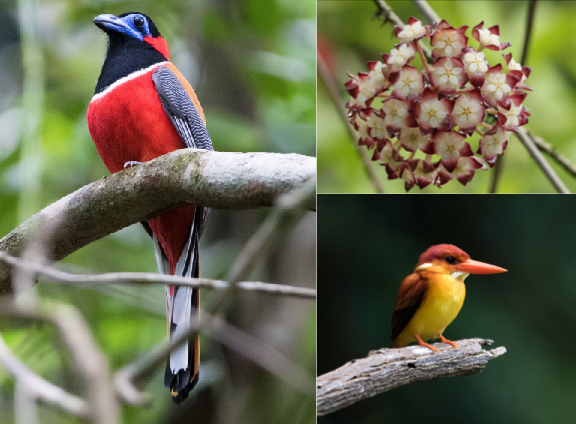Our new PNAS paper on historical extinctions in Singapore is out
What are the impacts of tropical deforestation on biodiversity? To assess this, case studies are needed of tropical regions that have both a history of substantial deforestation and reliable biodiversity data. Singapore was almost entirely forested two hundred years ago but today less than 1% of the original primary forest remains today, with an additional ~20% of the landscape covered in lower quality secondary forest. Singapore also has an exceptionally detailed biodiversity record. Many species have gone extinct from Singapore, from the majestic tiger, the last of which was shot in the 1930s, to the humble epiphyte Hoya finlaysonii, which was last seen in 1837.

A selection of species that have been extirpated from Singapore in the last 200 years. Left: Red-naped Trogon (Harpactes kasumba). Top-right: Hoya finlaysonii. Bottom-right: Oriental Dwarf Kingfisher (Ceyx erithaca). Image credits: Ang Wee Foong (H. finlaysonii), Yong Chee Keita Sin (bird photos).
We compiled a comprehensive dataset of biodiversity in Singapore, comprising more than 50,000 individual records and representing more than 3,000 species and ten major taxonomic groups (mammals, birds, reptiles, amphibians, freshwater fishes, butterflies, bees, phasmids, decapod crustaceans, and plants). We developed novel statistical methods that account for “dark extinctions”, i.e., extinctions of undiscovered species, and estimated that 37% of Singapore’s species have gone extinct over the last two centuries. We extrapolated Singapore’s historical experience to a future scenario for the whole of Southeast Asia and estimated that around 18% of species would be lost regionally by 2100.
Our extinction estimates for both Singapore and future Southeast Asia are a factor of two lower than previous estimates, which we attribute to our improved statistical methods. However, extinctions in Singapore have been concentrated among charismatic species, including large mammals, forest-dependent birds, butterflies, and orchids. Thus, we speculate that if deforestation continues across the region, Southeast Asia may come to resemble a “tropical Europe”, where a large majority of species persist in a human-dominated landscape, but where many of the most charismatic species are absent. We recommend that future tropical conservation efforts focus on charismatic species such as tigers, elephants, rhinoceroses and orangutans, in line with the classic umbrella species approach.
The paper has just been published in PNAS. It represents the culmination of a decade of work by many people to assemble the comprehensive database of Singapore biodiversity records and develop the novel statistical methods needed to account for dark extinctions.
Chisholm, R. A., N. P. Kristensen, F. E. Rheindt, K. Y. Chong, J. S. Ascher, K. K. P. Lim, P. K. L. Ng, D. C. J. Yeo, R. Meier, H. H. Tan, X. Giam, Y. S. Yeoh, W. W. Seah, L. M. Berman, H. Z. Tan, K. R. Sadanandan, M. Theng, W. F. A. Jusoh, A. Jain, B. Huertas, D. J. X. Tan, A. C. R. Ng, A. Teo, Z. Yiwen, T. J. Y. Cho, and Y. C. K. Sin. 2023. Two centuries of biodiversity discovery and loss in Singapore. Proceedings of the National Academy of Sciences 120:e2309034120